|
START YOUR ENGINES!
Grand Prix/Formula One racing is one of the most exciting sports in the world.
To be a Grand Prix driver, you must not only have a mind like a computer and
reflexes like a mongoose, but you must also be an expert on racing technology
and an excellent business manager.
Ferrari Formula One brings all of the depth and excitement of the Grand Prix
race circuit to your computer. You'll have plenty of races to run, but you'll also
have a pit crew to manage, a Ferrari Formula One 1986 (F186) race car to modify
and test, deadlines to meet, and schedules to keep. But all of this is only for
those who want to run the full simulation. If you just want to get behind the
wheel of a Ferrari (the most successful Grand Prix racing team in the world),
then you can do that as well.
HOW TO USE THIS MANUAL
This manual is designed so that you can use just as much of it as you want.
It covers everything about the Ferrari Formula One simulation, from Formula One World
Driving Championship rules, to travelling to and competing in your first race.
However, if you want to simply drive without worrying about schedules and your season
standing, then you probably don't need to read this manual.
Just take a moment to carefully read the Driver's Reference Guide.
It provides everything you need to get started quickly including how to control your Ferrari,
the specific features and keyboard shortcuts for your computer, and other information you'll
probably want to keep handy as you race. And because Ferrari Formula One is available on a
number of different computers with differing capabilities, some of the features and functions
described in this manual may be different on your computer. The Driver's Reference Guide
will help you deal with those differences as well.
ABOUT THE GRAND PRIX AND THIS SIMULATION
There are a lot of rules in Formula One World Driving Championship racing.
The majority of Formula One rules apply to car design and specifications.
You won't need to worry about these rules too much because Ferrari Formula One
won't let you modify your car beyond the parameters laid down by Formula One rules.
In other words, Ferrari Formula One lets you make adjustments to your F186
(like changing the attack of the wings), but you won't be able to alter the car's structure
(like making the wings larger), because this is against Formula One rules.
A Grand Prix race season consists of a series of races, each at a different track.
Each race consists of:
Practice One (P1)
In the morning, two days before the race. This is where you get acquainted with the
track and your opponents.
Qualifying One (Q1)
In the afternoon, after P1. This is the first real competition of the race.
In qualifying you're competing with the other drivers for the best grid position for
the start of the race. Your starting position is based upon your best lap time during
qualifying. You'll want to adjust your car radically and push it to its limits.
Practice Two (P2)
In the morning of the day before the race. Continue to familiarise yourself with the
track and prepare to improve your time for the second qualifying session.
Qualifying Two (Q2)
In the afternoon, after P2. Once again, adjust and push your car to its limits to try
and make the best qualifying time.
Warm-up
On the morning of the race. This is a 30 minute session
in which you'll make a final inspection of the track, and your opponents' strengths
and weaknesses. Take it easy on your car during the warm-up race -
don't take the risk of destroying your engine before the race even starts because
you probably won't have time to replace the engine before the race begins.
Note: Track testing time is probably your most limited resource during a Grand Prix.
In a little over four hours you must:
* Learn the track and its layout.
* Find the fastest setting for the Qualifying sessions.
* Secure a good grid position.
* Find the best combination of speed and endurance for the race.
* Find the fuel economy that will let you complete the race.
Make sure that you spend time driving your car in race trim.
The wrong time to find the right settings is after the green flag drops.
Race
With your car tuned to the best balance of speed and endurance,
this is where you'll engage in competition for the race trophy.
A Grand Prix race normally lasts two-hours or about 315 kilometres, whichever comes first,
but you can use the race control (described later) to select races as short as 2-5 laps
(about 18 kilometres). If the race doesn't run the full distance within tow hours
(or the time limit for a shorter race), then the lead car is the winner. Unlike the practice,
qualifying, and warm-up sessions, you can't refuel during the actual race.
Ferrari Formula One, the simulation, operates just like the Grand Prix race circuit
in the real world. The moment you boot the program the clock starts ticking.
You must get yourself and your car into shape in time to transport yourself, your equipment,
and your crew to the first race of the season. Car repair and travel time is accelerated,
but all other aspects of Ferrari Formula One are in real-time. Furthermore, if you damage
your car before, during, or after the race, you'll receive a time penalty in the amount it
would really take to put your car back in working condition, or your body back in shape if
you were injured in the crash. A really bad crash may put you out for the rest of the season.
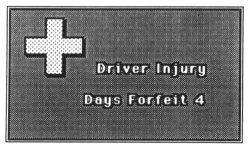
Figure 1: An Injury Penalty
FIORANO - LAUNCHING YOUR CAREER
Fiorano (pronounced FEE-OH-RON-OH) is your home base and test track.
Fiorano has all the facilities you'll need to coax the best performance out of your
Ferrari and to hone your own driving skills. And your crew chief is always available to
help you make the set-up decisions that can determine race outcome.
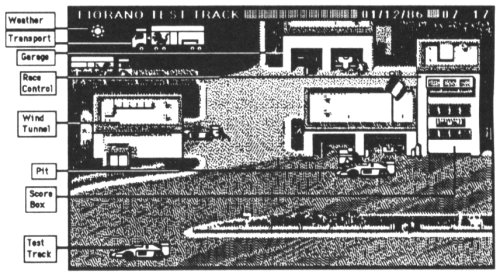
Figure 2: Fiarano Paddock
WHO'S MAURO?
Mauro is your computerised crew chief who's always available when your car is in the pit
or garage.
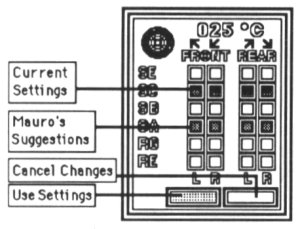
Figure 3: Ferrari Control Panel With
Current Settings And Mauro's Suggestions
Select the toolbox to get Mauro's suggestions on car adjustments.
When you select the toolbox, all the control panels for your Ferrari will open.
Solid squares highlight Mauro's suggested settings just as if you had selected them yourself.
If Mauro's settings are the same as the current settings, only Mauro's settings will show
on the control panel. When you are playing at F3 level, Mauro's settings automatically take
effect each time you go to a new track.
Note: After you have driven the car, some of the current setting squares may be
partially blacked-out, indicating wear. A solid black square means that component is no
longer operational.
MAP OF FIORANO
The Fiorano paddock is made up of seven different areas. You can get to the different areas
of Fiorano by selecting one from the paddock screen. See the Driver's Reference Guide to
learn how to select screen areas on your computer. Fiorano paddock is very similar to the
paddocks of the competition tracks, except that it has some additional facilities that you
won't find at the competition tracks (see "Competition Track Layout" under Your First Race
for more information on competition tracks). The following sections describe each of Fiorano's
areas in detail.
RACE CONTROL
This is where you pick the race settings such as track, session, race length, and driver name.
The race control panel appears when you select the second floor race control building. Figure 4
below shows the race control panel and each of its controls.
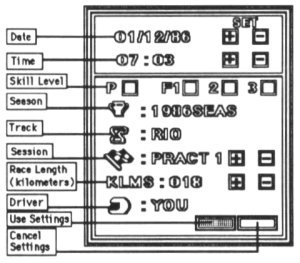
Figure 4: Race Control Panel
You can use the date and time controls, or the track and session controls to quickly
advance a race season if you are trying to run a season from start to finish.
When you choose the track control, a list of the various race tracks appears for you to
choose from. Choosing a track resets the clock, calendar, and session control to the first
session of that race.
The session control changes the selected session and resets the clock
and calendar for that session. you'll notice that once you pass the last session of a race,
the session control also switches the track control to the next race of the season.
Note: Unlike the transport trucks, selecting a new track or session from the race control
panel sets the clock and calendar ahead to the day of the current track session. This means
that you can use it to skip races. But if you are keeping a record of your season standings,
you won't have scores for the races you've skipped. Also, if you use the race control to go
back and repeat a session, you'll forfeit your accumulated season standings.
The skill level control lets you set Ferrari Formula One's difficulty from Formula One
(F1 - the hardest) to Formula Three (F3 - the easiest). The harder the skill level, the more
skilfully your opponents will drive and the more likely that wear and tear will cause a
mechanical failure in your car. At the F1 level, you must also shift gears manually
(see the Driver's Reference Guide for information on manual shifting).
The P in the skill level area of the control panel lets you leave the driving to us so
you can view the race as a passenger. (But you still call the shots when it comes to car
repairs, even though you're only a passenger during the race.)
The driver control lets you enter your own name as a driver for the season.
The name you enter here will appear before your score on the season standings screen.
The trophy control lets you save your current season to disk, or load another season from disk.
You'll need a formatted/initialised, blank disk in order to save your seasons.
See the Driver's Reference Guide for more information on saving your season statistics,
and see your computer's users' manual for instructions on formatting or initialising blank
disks.
GARAGE
The garage is where you'll adjust your Ferrari's major systems before you take it out to
the test track or to a race.
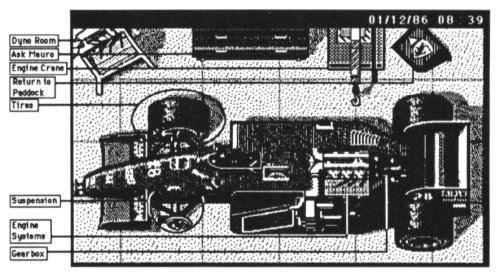
Figure 5: The Garage
Select the garage building to enter the garage. Figure 5 (above) shows the inside of the garage
and the eight screen areas you can select for garage functions. See the Setting Up Your
Ferrari section below for more detailed information on using the garage. The dyno room is
also located in the garage (at Fiorano only). See "Dyno Room" in the Testing You Car"
section below for a description of, and information on using the dyno room.
WIND TUNNEL
The Fiorano wind tunnel is where you'll learn to make adjustments to your Ferrari's wings,
and then test to make sure your adjustments are aerodynamically sound.
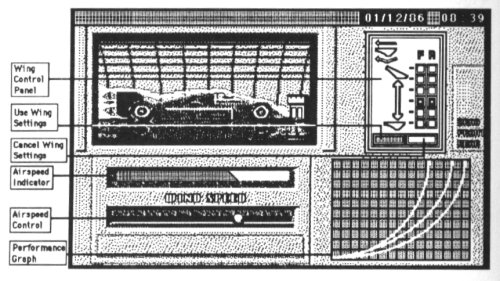
Figure 6: The Wind Tunnel
The adjustments you make to your Ferrari's wings affects the way the car handles on the
track, so the wind tunnel plays an important part in developing a winning Ferrari.
Select the wind tunnel building to put your Ferrari in the wind tunnel.
Figure 6 (above) shows the inside of the wind tunnel and the controls you can use. See "Wind Tunnel"
in the Testing Your Car section below for more detailed information on using the wind tunnel.
PIT
The pit is the place where you fine tune the major adjustments you performed on your Ferrari
in the garage.
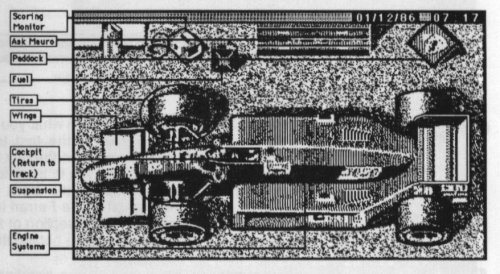
Figure 7: The Pit
You can select the pit building to put your car directly into the pit from the paddock,
or if you have a problem on the track, just pull off the right side of the trace after the
start/finish line (the area without a curb) into the pit and ask Mauro's advice.
The pit has most of the features of the garage except for the dyno room,
the engine crane for changing engines, and the ability to change gear ratios.
The dyno room is available only at Fiorano.
In the pit, however, you can also adjust your car's wings, refuel
(except when Formula One rules prohibit it), and see your current lap times and the
weather conditions on the scoring monitor. During competition, you can also use the
scoring monitor to see the overall race scoring. When you're done in the pit you can
return to the track by selecting the Ferrari's cockpit.
Figure 7 shows the inside of the pit and the nine screen areas you can select to use
its various functions. See the Setting Up your Ferrari section below for more detailed
information on using the pit.
Note: Your pit crew's accuracy and speed will vary depending on whether you're in the
garage or the pit, and depending on whether you're practicing, qualifying, or racing.
TEST TRACK
Your pit crew's accuracy and speed will vary depending on whether you're in the garage
or the pit, and depending on whether you're practising, qualifying, or racing.
When you have your Ferrari set up in what you think will be a winning configuration,
it's time to take to the test track to see how she performs. There are no other cars on
the test track except yours, so this makes it a good place for you to learn to drive at
high speeds. Select the car that's lined up on the track at the bottom of the paddock
screen, or the cockpit of the Ferrari in the pit to move onto the track.
See the Going for a Lap section of the Driver's Reference Guide for more information on
getting behind the wheel of your car.
SEASON STANDINGS
Season standings is housed in the building directly below race control and shows your
overall season standing.
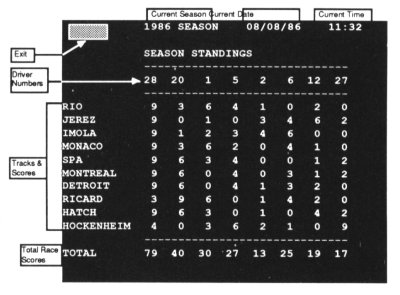
Figure 8: Score Box
Figure 8 shows the season's standings. You can save your season standings screen to
disk and view them again later using this screen (see your Driver's Reference Guide).
During the 1986 season, the season score for a driver was calculated by using the
11 best scores out of all 16 races. The driver gets a certain number of points per race,
based upon his finishing position. Table 1 shows the correlation between points and
finishing position.
TABLE 1:
POINTS - POSITION
9 - 1st place
6 - 2nd place
4 - 3rd place
3 - 4th place
2 - 5th place
1 - 6th place
TRANSPORT
The transport trucks take you to the competition track of your choice,
and advances the clock for the amount of time it takes to travel there.
The transport trucks let you travel to tracks early or between races
during the season so you can log extra test time. For instance,
if you select the transport trucks in January at Fiorano and choose Rio,
then you'll arrive at Rio two months before the race, which begins on March 19th
(see" Appendix A - 1986 Season Schedule"). You can still do practice laps even though
the track is closed.
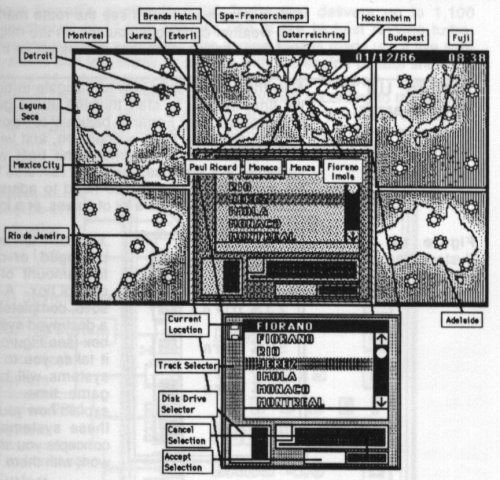
Figure 9: The Transport
When you select the transport trucks, a world map appears that shows your current
location and all the other track locations. Weather icons appear near each track
location to show you the weather conditions there. If you're testing your car or practising
between races, you can use the weather icons to select the weather conditions of your choice.
Select a track and you'll see the route marker appear as you travel. The weather
conditions you see on the map are for the current day, and may change in the time
it takes you to travel to your destination.
SETTING UP YOUR FERRARI
Now that you've seen how to navigate through Ferrari Formula One,
it's time for you to start thinking about getting your car ready for competition.
Your Ferrari is basically composed of five systems: engine, gearbox, tires, suspension,
and wings. You should look at track conditions to determine the best way to adjust your
car's systems. For instance, you'll pick rain tires for a wet track, and slicks for a dry track.
You'll also need to adjust the gearing and wings differently if a track has a lot of curves,
or a lot of straights.
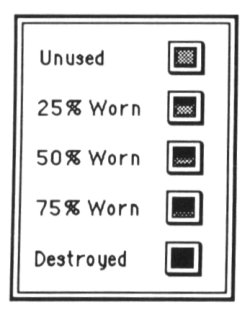
Figure 10: System Wear and Tear
You can tell when a system is worn, damaged, or completely destroyed by the amount of
filling in the system's control box. A brand new system has a solid, completely filled
control box, while a destroyed system has an empty control box (see figure 10). The amount of time it
takes you to repair one of your car's systems will be subtracted from your game time.
The following sections explain how you adjust, repair, or replace these systems,
and the theories and concepts you should be aware of as you work with them.
ENGINE
Your Ferrari's engine is a V6 Turbo that delivers up to 1,000 horsepower at 11,000 rpm;
it's one of the highest revving turbo-charged engines available. The engine itself is
made up of five sub-systems that you repair or replace with the engine control.
Just select the system you want to repair. The time it takes to repair the engine sub-system
varies according to the amount of damage it has taken, and when and where you make the repair.
The engine life and fuel level indicators display engine age and the amount of fuel only -
you can't adjust their status with the engine control.
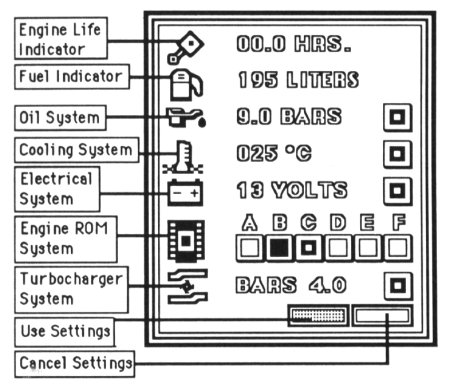
Figure 11: Engine Control
Engine life is a strong determining factor in engine performance.
An average time for engine life in the Grand Prix circuit is roughly six hours,
with a maximum life of 12 hours. This is when you'll get the optimum performance out of
the engine. Luckily, no race will ever last that long, but you'll use up some engine life
by burning it in during a pre-race warm-up. You'll see how engine life affects performance
when you learn to use the dyno room in the next section, Testing Your Car.
Note:
Formula One racing is one of the most expensive forms of motor racing in the world.
Car chassis are constructed from exotic materials such as carbon fibre, and front line drivers
can make more than three million dollars a year. Engines can cost in excess of $60,000.00
dollars apiece, and drivers will generally use three engines during a Grand Prix
(one for each Practice/Qualifying day, and a third in race configuration).
The time on the engine increases the longer you run the engine.
Using the engine crane in the garage resets your engine's life to 0 - the equivalent of
replacing your old engine with a new one. The only time you can replace your engine is
when your car is in the garage. This means that you can't replace an engine once a race has
begun, because leaving the pit to return to the garage is the same as dropping out of the race.
If you lose an engine during a race, you may as well head for the next race in the season.
FUEL LEVEL
Shows the amount of fuel left in your tank, in litres (195 maximum, according to 1986 rules).
Your Ferrari's fuel consumption is affected by other factors such as engine life,
engine ROM's, turboboost, and wing settings. For instance, the older an engine gets,
the less efficiently it will use fuel. Read the section on engine ROMs and turboboost
below for more information on those systems, see the "Tires" section for more information
on tire compounds. Using the fuel can in the pit during testing, practice, or before
qualifying fills your Ferrari's tank. The amount of fuel will usually be less during
qualifying runs so your car will be lighter and faster. The amount of fuel will also be
less if you are running a race that is shorter than a regulation race.
Because Grand Prix rules don't allow refuelling during a race,
the fuel can is removed from the pit during an actual race.
OIL SYSTEM
Is affected by engine life, temperature, ROMs, and turboboost.
Oil pressure is measured in bars (a bar is approximately 14.7 psi - pounds per square inch),
and has a maximum level of 9.0. Pull into the pit and fix your oil system immediately if
the oil or temperature indicators drop below half during a race
(see Driver's Reference Guide for cockpit controls and indicators).
High oil pressure is good, low oil pressure is bad.
COOLING SYSTEM
And the oil system are closely interlinked. The lower you let your oil pressure get,
the higher the water temperature will go. Engine temperatures will also rise if you've
been racing hard with a high turboboost setting, or running a very lean mixture
(see "Engine ROMs System" below).
ELECTRICAL SYSTEM
Provides the power which is essential to your Ferrari's ignition and fuel injection systems.
Because these systems are drawing full current during a race, there is a continual drain on
your electrical system. If your electrical system fails during race, so will your engine.
FUEL INJECTION/IGNITION COMPUTER ROM SYSTEM
Regulates your engine's fuel-air mixture and ignition timing.
ROMs (Read Only Memory) are computer chips that are installed in the engine to tell it
how to regulate the fuel to air ratio. The program contained in a ROM chip,
and your turbocharger setting, determines the horsepower output, power curve, fuel economy,
and wear characteristics of your engine. The ratio of fuel to air affects the temperature at
which the fuel burns, and the energy it provides. A rich fuel to air ratio burns more fuel
than a lean mixture.
A leaner mixture provides more horse power, but makes the engine run hotter, work harder,
and makes it more sensitive to excess turboboost. A richer mixture is more conservative on
the engine, and lets you use more boost from the turbocharger, but consumes fuel more rapidly.
Typically, you'll want a lean mixture during a race to conserve fuel, and also because
burning more fuel with a rich mixture doesn't necessarily increase horsepower. The A-ROM
is the leanest mixture, while the F-ROM is the richest mixture. The Q-ROM is an extremely
rich mixture that you should use only in qualifying races.
Note:
You can see just how the various ROMs and turbocharger settings affect your e
ngine's performance in the dyno room. See the "Testing Your Car" section for more
information on using the dyno room.
TURBOCHARGER SYSTEM
is a collection of components that increases the engine's horsepower by literally stuffing more
air and fuel into the engine. A small turbine, placed in the flow of the engine's exhaust,
spins an impeller that pumps pressurised air into the engine. The extra air forces the fuel
injection system to balance the mixture with more fuel, thus greatly increasing the potential
energy in the cylinder. But, as you might imagine, an increase in turboboost also increases
the engine's fuel consumption. An F186 in qualifying trim won't win any fuel economy awards.
Turboboost is measured in bars (a bar is approximately 14.7 psi - pounds per square inch).
The higher you set your turboboost, the more pressure you're putting on your engine.
Thus turboboost and engine wear have a direct correlation. If you run a high turboboost
setting for long periods of time, you increase your chances of blowing the engine -
especially at skill levels above F3. But the temptation to use full turboboost is always
great because the turbocharger can boost your Ferrari's overall horsepower by 100%,
thus increasing your top speed dramatically. If the turbocharger system sustains damage,
use the control in the engine control panel to repair it (the amount of time it takes to
repair will depend on the extent of the damage). If you should happen to blow your engine
during a race, then you'll lose the race.
GEARBOX
Use the gearbox control panel, shown in Figure 12 below, to adjust your Ferrari's gear ratio in response to track
conditions.
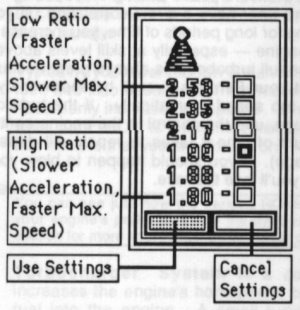
Figure 12: Gear Ratio Control
Short gear ratios provide fast acceleration, but lower maximum speed.
This means that you should use a short gear ratio for slower tracks with tight turns so
you can accelerate quickly out of the turns. Long gear ratios provide slow acceleration,
but higher maximum speeds. This means that you should use a long gear ratio for straighter
tracks where you can go fast for longer periods without slowing for curves.
Also be aware that shorter gears cause higher engine revs, and thus, greater fuel
consumption. For some races you may want to use a longer gear to help conserve fuel.
TYRES
Almost no other area has improved as much over the years as the performance of Grand Prix
tires. Cornering forces can reach better than three G's (forces of gravity).
Tires have become highly specialised for their specific duty, and are categorised by their
compound (the rubber composition that gives the tire its performance characteristics)
and tread design (the grooves cut into a tire based on track conditions). For instance,
there are different tire compounds and tread configurations for wet and dry weather,
or for hot and cold weather. Typically, wet weather tires are the only types that are treaded.
Dry weather tires have no treads, and are referred to as slicks.
The goal in picking tire compounds is to get the best grip, and thus, the best lap time.
The basic rule of thumb is: the softer the tire compound, the faster the lap time; but the
greater the wear on the tire. This means that you should attempt to find a happy balance
between lap time and tire longevity.
Choosing the appropriate tire compound is extremely important to the success of your race.
Each tire of the Formula One car is subjected to its own distinctive form of stress,
so you may have to pick a different tire compound for each tire of the vehicle.
Your choices should be based upon the layout of the track, the weather conditions, and the
track session you're competing in. Your goal is to pick tires that will become just the right
temperature during the race so you'll get good grip on the track. If a tire stays too cold,
it won't get soft enough to grip. If it gets too hot, it will smear, become sticky,
and deteriorate faster.
Let's say that you're racing on a track which has a lot of right-hand turns.
You would probably want to select a hard front-left compound, a fairly soft front-right,
and two medium-hard rear tires. The hard front-left compound will help the tire hold up
under the punishment it will receive in all of those right turns, while the soft front-right
compound will help provide additional grip. The medium-hard rear compounds will help the
rear tires survive the fast acceleration out of all the corners, but since the compound is
only medium-hard, it will also provide better grip than a very hard compound.
Three completely different compounds on the same car are quite common in Formula One racing.
The tire control (see Figure 13) in the garage and the pit gives you six tire compound/tread combinations
to choose from. The arrows at the top of the compound columns point to a tire on the car in
the following order from left to right; right-front, left-front, right rear, and left-rear.
The temperature for that tire appears at the top of the tire control when you select one of
the arrows. Table 1 lists the compounds, their types, and their degree of firmness.
Note:
Remember, letting your tires get too hot makes them deteriorate faster and reduces their
grip. You can monitor tire wear during a race by watching the movement patterns on the tires -
they'll change pattern as they get hotter. (You can watch the rear tires in the corners of your
rear-view mirrors.) If you see that the tire(s) are wearing too fast, slow down to conserve
them. You'll lose some lap time, but it's sometimes better than pulling into the pit for a
complete tire change.
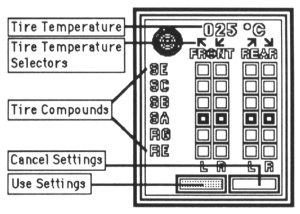
Figure 13: Tire Control
TABLE 2: Compounds, Types and Firmness
COMPOUND - TYPE - FIRMNESS
SE - Qualifying - Very Soft
SA - Race A - Hard
SB - Race B - Medium
SC - Race C - Soft
RG - Rain Qual. - Very Soft/Tread
RE - Rain Race - Soft/Tread
Rain tires are the softest compound, are water compatible, and they are treated to help
prevent hydroplaning. The rain compound lasts only so long as rainwater acts as a coolant
for the tires during the race. This means that they'll deteriorate rapidly on a drying track.
The ideal situation is to have all four tires reach their best gripping temperature at
full speed. Although you can reduce tire temperature by varying your driving tactics,
remember that this usually means slower lap times. Of course, losing a little time to let
the tires cool off is better than losing your first place slot if you have a narrow lead.
It takes less than 15 seconds to change the tires in the pit, but when you add the time
it takes to decelerate into and acceleration out of the pit, you'll lose about a minute.
Note:
Qualifying tires provide great grip because they are so soft, but they deteriorate fast.
They're designed to be destroyed because you need fast lap times while qualifying,
and you can usually afford the time it takes for a tire change during qualifying runs.
SUSPENSION
Your Ferrari's suspension system works in tandem with the wings and tires to help provide
the best handling characteristics. You should adjust the suspension system in response
to your own driving habits as well as to track conditions.
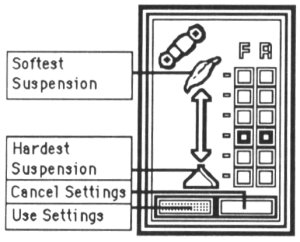
Figure 14: Suspension Control
The suspension system has a drastic effect on whether your car under or oversteers.
Understeering is when you go into a turn and the front tires break traction first,
causing them to wash-out (continue straight even though they're turned).
Oversteering is when the rear tires break traction first and make the car fishtail or,
in the worst cases, spin-out.
Firm suspension provides less sway, but is less forgiving of road inconsistencies and
will break traction faster. Soft suspension has the exact opposite effect.
For instance, firm rear suspension and soft front may make the care more likely to
oversteer; i.e., the rear tires may break traction first and the car may fishtail or spin-out.
When you're adjusting your car's suspension, take into account whether the track is
twisty or fairly straight, and whether it's wet or dry. Also, the F186 has a natural
tendency to understeer, so calculate this into your adjustments. Finally, you must also
consider your own driving habits. For instance, if you like to take corners at
high-speeds with little or no braking, then you'll probably want to use firmer rear
suspension to make the car oversteer slightly.
But keep in mind that the car is more likely to break traction and go into a skid if you
have to use the brakes too heavily into a turn. You should also take your tire and wing
setting into account when adjusting the suspension. If you're using a soft tire compound,
and wing settings that provide less of downforce (see "Wings" below), then you can probably
afford to use a firmer suspension system.
WINGS
Next to proper tires, you car's wings are the next most important factor affecting how the
car handles on the track. Your Ferrari's front and rear airplane's wings operate exactly
like an inverted airplane wing. While an airplane's wing provides life, your Ferrari's
wings are turned upside-down so they provide downforce. Essentially, they push your car
down onto the track to provide better grip around corners and other areas where you might
lose ground. The wings also help compensate for under/oversteer which was discussed in the
last section, "Suspension."
The higher you put the rear edge of the wing (or the greater the angle of attach),
the more downforce it provides when the car moves forward. But this also creates more drag,
which hinders the car's forward motion, and this, its acceleration. Your job is to find a
happy medium between downforce and drag. But remember that the effect is exponential with
speed; that is, the faster you go, the less wing you'll need to create the downforce,
and straight line acceleration versus cornering speeds. Wing Control is used to adjust your
car's front and rear wings.
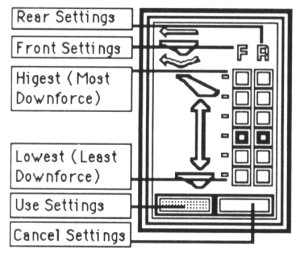
Figure 15: Wing Control
Like all the other components of your Ferrari, the way you adjust your wings depends upon
track conditions. On a very twisty track, you might have to sacrifice some top speed
(because of increased drag) in order to get a lot of cornering performance (because of
increased downforce). On a track with a lot of straights, you might sacrifice speed
(because of decreased drag). You can see the way wing adjustment affects downforce and
drag by testing your car in the wind tunnel (see "Wind Tunnel" below).
TESTING YOUR CAR
Before you leave Fiorano for your first race, you should test your car using Fiorano's test
lab facilities to learn exactly how your adjustments affect your car. The following sections
describe each of Fiorano's test labs and how you should use them.
DYNO ROOM
By adjusting the various controls in the dyno room you can quickly see how engine
performance is affected at various speeds (RPM) by the age of the engine (HRS),
turbocharger settings (BST), and the ROM type. In all likelihood, the fuel efficiency in an
older engine won't be nearly as good, and other factors such as the cooling and electrical
systems will be less efficient also.
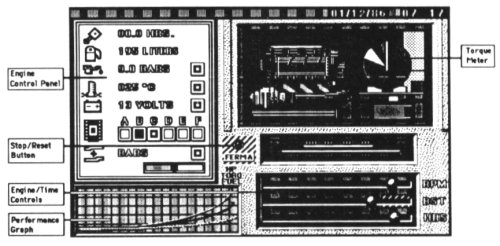
Figure 16: The Dyno Room
The performance graph below the engine control shows the way in which increasing the
output of one engine factor decreases or increases the efficiency of another.
For instance when you increase turboboost (the BST control), horsepower (HP) and engine
torque (TORQ) increases but fuel efficiency (FUEL) drops. Try increasing the engine age
with the HRS control and see what happens to the engine's performance
(once you age an engine with the HRS control, you cannot make it young again; you must use
the engine crane in the garage to install a new engine).
Note also, the RPMs at which your engine reaches peak performance in its current tune.
you should try to shift at this RPM if you use the same engine turn on the track.
WIND TUNNEL
The wind tunnel is where you see how your Ferrari's wings affect downforce and drag.
Use the wing control panel to adjust the angle of attack of the car's wings, then use the
airspeed control to increase the speed of airflow across the wings. The performance graph
below the wing control shows you how downforce on the front and rear wings, and the overall
drag will increase as the speed of your car increases.
Your goal is to find the greatest increase of downforce with the least drag at the highest
wind sped. Naturally, this all depends on race track conditions - your wing settings
will probably be different for every track.
TEST TRACK
The Fiorano test track is where you measure the F186's performance after making all your
adjustments in the garage and pit. You should also work to hone your driving skills here
before an actual race. In particular, practice braking into corners from high speed since
this is typically where new drivers are overtaken by experienced Grand Prix race drivers.
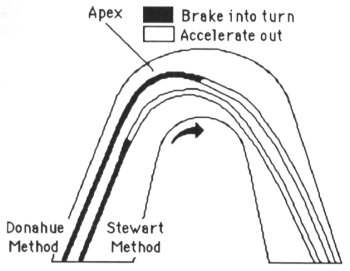
Figure 17: How To Corner
The most common tactic is to configure your car so it understeers into the corner,
and oversteers out. You achieve this with a fine balance of wing and suspension settings.
There are two schools of though on the best way to negotiate a corner; the traditional method,
recommended by Jackie Stewart and others; and the friction circle method, pioneered by Mark
Donahue.
Using the friction circle method, you brake to the apex of the turn, and accelerate out.
Using the traditional method, you brake into the beginning of the turn, then accelerate all
the way through the apex and out of the turn. Use whichever method feels right for you.
Your main objective on the test track should be to increase your lap time and your car's
performance. pull into the pit after every few laps and check your car's systems for wear and
tear, and check the race monitor for your lap times. If it looks like some of your car's
systems are really taking a beating after only two or three laps, try driving more
conservatively. Be prepared for longer lap times though. If after two or three more laps
your car is still taking a beating, you should make some adjustments to those systems that
aren't holding up well.
SCORING MONITOR
The scoring monitor in the pit at Fiorano shows a lot more than just your lap times.
There are sensors at every turn of the test track that record exactly how you performed
during a given lap. Click the button next to the lap time you want to analyse, and the
scoring monitor will show you the times recorded at each sensor. Using the information
gathered by the sensors around the test track, you can isolate and work on the areas of
your driving that need improvements.
The scoring monitor during a race shows the current status of all race participants,
ranked by position. You can see what lap the other drivers are on, their times, and
whether they're on the track or in the pit (a "P" appears next to the name of drivers
who are currently in the pit).

Figure 18: Fiorano Test Track and Sensor Placement
The time shown for each sensor location on the race monitor indicates the time it
took you to reach that sensor from the last, and the total lap time up to that point.
Compare the numbers with previous laps to note your improvement (or lack of improvement).
Note:
Smoothness and consistency are the keys to turning fast lap times. The greatest cornering
forces occur during the transition from braking to acceleration as the weight of the car
is magnified by momentum. If you can make a smooth transition, you can reduce the impact
of the transition. Consistency lets you avoid problems and execute the most important of
all racing strategies - finishing. The more control you maintain, the closer you can drive
to the car's limits.
TRANSPORT
When you feel confident in your car and your capabilities as a driver, it's time to head
for your first race of the season (see "Appendix A - 1986 Season Schedule" for race dates).
The first race is held at Rio, on March 23rd. If you have spent enough time testing and
practising at Fiorano for the game date to almost reach the date of the first race,
you can take the transport trucks there. Using the transport trucks to get to another
track sets the game clock ahead only for the amount of travel time it takes to get there
from your current location. This means that to get from Fiorano to Rio in time for the
race you should leave Fiorano no later than March 19th.
The difference between using the transport trucks and the race control panel to go to
races is that the transport trucks simulate real-time in the game,
while the race control panel lets you advance the game clock and skip ahead to where
you want to be. You can use the race control to skip over the sessions except the race
itself (but you forfeit a good starting position), or you can even use it to skip over
entire races. But remember, you forfeit the races that you skip.
You can still take the transport trucks to competition tracks even if it's before or
after the date of the actual race, but you can only test on the track when you get there.
The travel times are as follows:
* One day to travel to another track in the same country as your current location.
* Two days to travel to another track on the same continent as your current location.
* Three days to travel to another track on a different continent from your current location.
If you want to go to the actual race, but the game clock hasn't yet reached the date
of the race, then use the race control panel located in the race control building of
the paddock, to select the track you want to go to. Race control automatically sets
the game clock ahead to the track's opening.
YOUR FIRST RACE
It's March 19, 1986. You know your Ferrari like the back of your hand and you could drive
Fiorano in your sleep. Now it's time to get your car and crew packed up in the transport
trucks and head for your first race of the season - Rio.
Held at Rio de Janeiro in March, the Brazilian Grand Prix is 5.013 km/3.126 mil
course that features one very long straight away, and a lot of challenging left-hand turns.
The weather is typically hot and dry.
COMPETITION TRACK LAYOUT
Like Fiorano, each competition track has a paddock area that contains the transport trucks,
garage, race control, scoring, pit, and race track access (see Figure 19).
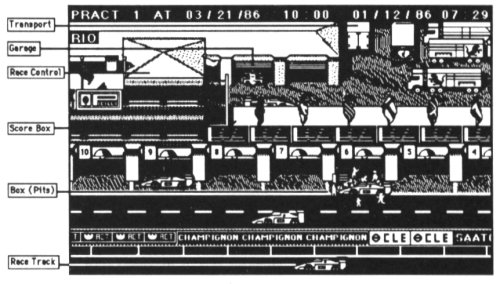
Figure 19: Competition Track Paddock
However, the competition tracks do not have wind tunnel or dyno room facilities.
The first thing you should do when you arrive at a competition race track is to note
the date, time, and weather conditions, which are shown as an icon near the upper-left
corner of the paddock screen. If you're early for the race, you'll have time to take some
practice laps around the track and get some first impressions. Then you should put your
car in the garage and make your adjustments based on the track conditions and the current
track session.
THE GRAND PRIX
A Grand Prix is broken into various track sessions that make up the entire race.
There are a total of six track sessions, including the race itself, which are spread
across a three day period. On each day, the first session is always at ten in the morning,
and the second session is at one in the afternoon. You can check the main paddock to see
what time it is and when the next session begins. The track sessions follow one another
logically as you complete them, or you can select the session you want to race from the
race control panel in the race control building of the paddock.
You can use the race control panel to skip the sessions before the actual race,
but you'll have to settle for a grid position at the back of the pack if you skip both
qualifying sessions.
DAY ONE
There are two sessions on the first day of the Grand Prix; the first practice session (P1)
and the first qualifying session (Q1). P1 is a practice session in the morning that gets
you acquainted with the track. Although you'll meet the other drivers on the track, don't
expect to see them show all their capabilities during this session. You should hold back and
take it easy during the practice session as well. Get to know the layout and trouble spots
of the track, and don't risk damaging your car.
* A green flag means the race is on at full speed.
* A white flag means there is one lap remaining.
*A chequered flag means the end of the race.
*A red flag means the course is closed, proceed to the pit.
Q1, in the afternoon, is the first real competition of the race. In this session you
are trying to qualify for the best grid position; that is, the position your car occupies
in the pack at the start of the race. The driver with the best flying lap
(like a running start) time gets the pole position.
Note:
You'll need to find a free stretch of road in order to find your fastest qualifying time.
As you start your second lap, make sure you have some traffic-free distance in front of you.
Remember that there are other drivers also trying to get fast times. All will be running at
different speeds, many in excess of 100 mph. This is one of the two most dangerous times
in Formula One racing (the other is Q2).
Use the Q engine RPOM, lots of turboboost, and qualifying tires to try and get the best
lap time. You will also lighten your car's load by using less fuel because you can refuel at
any time during the qualifying and practice races. This means you can reach faster speeds
and you don't need to worry about fuel efficiency. Do the best you can to get the best lap
time you can, but don't risk damaging your car - you still have two more practices and
another qualifying session to get through before the real thing.
And watch the other drivers as well. Although they won't show you all their tricks during
qualifying, some of their strategy and tactics may become apparent.
Note:
Pay attention to tire wear during the practice and qualifying sessions.
If your tires are wearing unevenly, try to select a better balance of compounds to
use in the race.
DAY TWO
Day two of a Grand Prix is also composed of two sessions: Practice Two and Qualifying Two.
Like P1, P2 is intended o help you familiarise yourself with every inch of the track.
The goal to make your P2 times better than your P1 times of the day before.
It also gives you a chance to tweek your car to peak performance.
Note:
Outside of the Ferrari factory in Maranello, Italy, there is a bust of Gilles
Villeneuve. Gilles was a Canadian Grand Prix driver for the Ferrari team in the late
'70's and early '80's. Gilles was well likes for his competitive spirit, and his success.
He placed second in the 1979 World Championship, and won six races in four years for Ferrari.
Gilles was killed in the early '80's while trying to overtake another car during a
qualifying session. The Canadian Grand Prix circuit was named in his honour.
Q2 is likely to be even crazier than Q1 as the drivers try to improve on their qualifying
times from the previous day, and beat everyone else's times in the process.
If your lap times happen to match another driver's from the previous day, the other driver
receives that pole position (because he reached it first) and you get the next in line.
Again, get radical with your car adjustments. Don't worry about fuel efficiency and tire wear,
just try to get your bet time. And don't forget to keep you eye on the competition.
Note:
Many Grand Prix drivers like to replace their engines after Q1 and Q2 so they'll have a
brand new engine for the sessions of the next day.
DAY THREE - THE RACE
Day three starts with a 30-minute warm-up session in the morning, followed by the race itself
in that afternoon. The warm-up session is your final chance to overcome any problem areas
the track may present for you. It's also a last chance to tune your car one last time.
Take it easy during the warm-up, burn-in that new engine gently, and conserve yourself and
your car for the race.
Your place at the start of the race in the afternoon is based upon how well you performed
in qualification. If you did well in Q1 and Q2, then you'll have a place at, or near,
the front of the pack. If you didn't do so well during qualifying, you'll be at the back of
the pack.
Note:
The standing start is one of the most spectacular moments in all motor sport.
Especially since turbo cars have found their way into Formula One. Cars often overtake
six to eight spots on the grid before the first turn. Others may stall on the grid,
causing gridlock at over 100 mph!
Drive aggressively, but remember, you can't refuel during the race, and a tire change is
the most time-costly of the standard problems. By "standard" we mean a problem that
probably won't cost you the race, only a lap or so. If you encounter a non-standard problem
during the race - like having to change your turbo charger system - then you will lose
the race.
A regulation Grand Prix is two hours or 310 kilometres (200 miles), whichever comes first.
You can get a shorter distance using the race control panel in the race control building
at the paddock if you want (this also scales down the time limit and fuel capacity).
If the time limit is exceeded and you haven't run the full length of the race, then the lead
car is declared the winner as he crosses the finish line and the race ends. After the race,
you can save the season standings to disk (see your Driver's Reference Guide).
Note:
If you did not finish the race, the reason will be listed in the race results
screen. For instance, the word "SHUNT" means that you had an accident. "DNF" is short for
Did Not Finish and appears when you deliberately leave the race. If a component from your
car is listed (i.e., "WINGS", "ENGINE", and so on), then there was a mechanical failure
in your car that prevented you from placing.
RETURNING TO FIORANO
Hopefully you did well in your first race, but if you didn't, then maybe it's time to return
to Fiorano and practice some more. Use the transport trucks to return to Fiorano in the same
way you used them to get to the first race. You can also go to other competition tracks to
test if you want, but it won't register in your season standings if the track is closed.
APPENDIX A - 1986 SEASON SCHEDULE
Race - Date - Location
Rio - 3/21-3/23/86 - Jacarepagua, Rio de Janeiro
Jerez - 4/11-4/13/86 - Jerez, Spain
Imola - 4/25-4/27/86 - Imola, Italy
Monaco - 5/9-5/11/86 - Monaco
Spa - 5/23-5/25/86 - Spa, Belgium
Montreal - 6/13-6/15/86 - Montreal, Canada
Detroit - 6/20-6/22/86 - Detroit, United States
Ricard - 7/4-7/6/86 - Paul Ricard, France
Hatch - 7/11-7/13/86 - Brands Hatch, England
Hockenheim - 7/25-7/27/86 - Hockenheim, Germany
Budapest - 8/8-8/10/86 - Hungaroring, Budapest, Hungary
Osterreich - 9/5-9/7/86 - Osterreichring, Austria
Monza - 9/5-9/7/86 - Monza, Italy
Estoril - 9/19-9/21/86 - Estoril, Portugal
Mexico - 10/10-10/12/86 - Mexico City, Mexico
Adelaide - 10/24-10/26/86 - Adelaide, South Australia
|